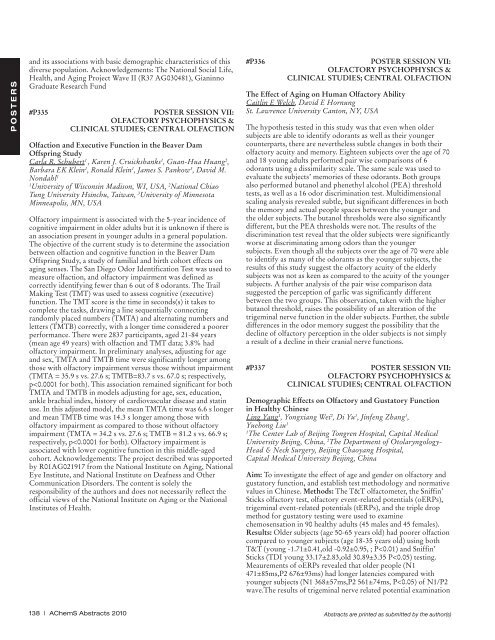Abstracts - Association for Chemoreception Sciences
Abstracts - Association for Chemoreception Sciences
Abstracts - Association for Chemoreception Sciences
Create successful ePaper yourself
Turn your PDF publications into a flip-book with our unique Google optimized e-Paper software.
P O S T E R S<br />
and its associations with basic demographic characteristics of this<br />
diverse population. Acknowledgements: The National Social Life,<br />
Health, and Aging Project Wave II (R37 AG030481), Gianinno<br />
Graduate Research Fund<br />
#P335 POSTER SESSION VII:<br />
OLFACTORY PSYCHOPHYSICS &<br />
CLINICAL STUDIES; CENTRAL OLFACTION<br />
Olfaction and Executive Function in the Beaver Dam<br />
Offspring Study<br />
Carla R. Schubert 1 , Karen J. Cruickshanks 1 , Guan-Hua Huang 2 ,<br />
Barbara EK Klein 1 , Ronald Klein 1 , James S. Pankow 3 , David M.<br />
Nondahl 1<br />
1<br />
University of Wisconsin Madison, WI, USA, 2 National Chiao<br />
Tung University Hsinchu, Taiwan, 3 University of Minnesota<br />
Minneapolis, MN, USA<br />
Olfactory impairment is associated with the 5-year incidence of<br />
cognitive impairment in older adults but it is unknown if there is<br />
an association present in younger adults in a general population.<br />
The objective of the current study is to determine the association<br />
between olfaction and cognitive function in the Beaver Dam<br />
Offspring Study, a study of familial and birth cohort effects on<br />
aging senses. The San Diego Odor Identification Test was used to<br />
measure olfaction, and olfactory impairment was defined as<br />
correctly identifying fewer than 6 out of 8 odorants. The Trail<br />
Making Test (TMT) was used to assess cognitive (executive)<br />
function. The TMT score is the time in seconds(s) it takes to<br />
complete the tasks, drawing a line sequentially connecting<br />
randomly placed numbers (TMTA) and alternating numbers and<br />
letters (TMTB) correctly, with a longer time considered a poorer<br />
per<strong>for</strong>mance. There were 2837 participants, aged 21-84 years<br />
(mean age 49 years) with olfaction and TMT data; 3.8% had<br />
olfactory impairment. In preliminary analyses, adjusting <strong>for</strong> age<br />
and sex, TMTA and TMTB time were significantly longer among<br />
those with olfactory impairment versus those without impairment<br />
(TMTA = 35.9 s vs. 27.6 s; TMTB=83.7 s vs. 67.0 s; respectively,<br />
p
















